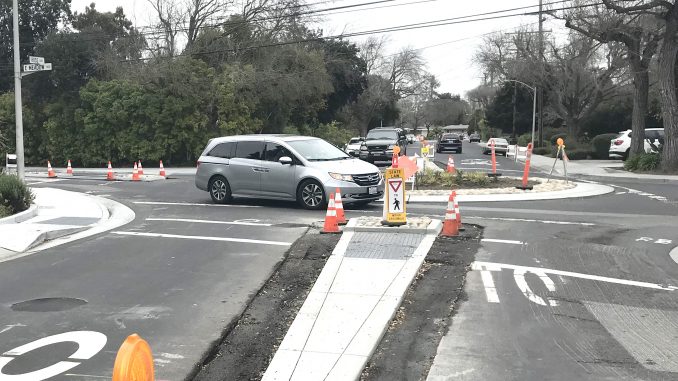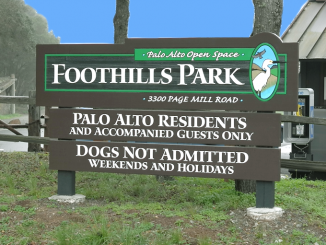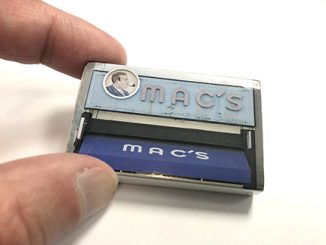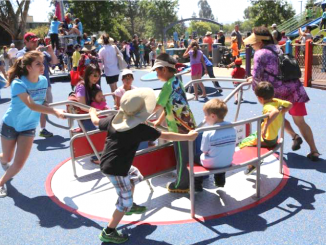
BY EMILY MIBACH
Daily Post Staff Writer
Harsh criticism of the Palo Alto City Council and some city employees was handed down last night (June 12) by about half of the 50 or so residents who spoke out about the Ross Road and East Meadow Drive roundabout and bicycle boulevard plan. Others praised the changes, saying it improved the area.
The roundabout along with curb extensions and speed bumps were installed as part of an $8.7 million bicycle boulevard plan that calls for 10 more roundabouts throughout town.
Instead of creating bike lanes on the side of the street, the city’s plan is to slow car traffic with bumps and curb extensions and have bicyclists share the same lane with cars.
“This is the epitome of incompetence,” said resident Terry Martin. “This project is an incredible waste of money … and there is a design flaw that will kill someone.” Martin, who is an engineer, said it’s possible for a young cyclist to not see one of the curb bulb-outs, hit it at a fast speed and go flying off of their bicycle. Martin said that sort of accident can lead to a fatal neck or head injury.
“I’ve voted in every election since 1969, (but) I’ve never voted for council, because I wasn’t paying attention. That will change,” Martin said.
Other residents also said they were worried the bulb-outs, the bumps and the idea that having cars share lanes with bikes would result in injuries.
Some parents, such as Lily Lam and Jennifer Liu, said their children no longer feel safe riding their bikes on Ross anymore. Both parents said they wanted to like the changes to the road, but because their children don’t feel safe, they don’t support the changes.
Former Mayor Betsey Bechtel, who was on council in the 1980s when the Bryant Street bicycle boulevard was approved, also criticized the plan. Bechtel said the plans for the bicycle boulevards were difficult to comprehend. She also called the city’s former bicycle consultant, John Ciccarelli, who said the only changes the city needed to make were adding speed bumps. The curb extensions weren’t necessary.
Not everyone was critical
However, some residents were pleased with the changes to Ross Road.
Ross Road resident Tania Nanevicz, who lives across from the YMCA, says she was initially skeptical when she saw all of the work begin on the street, but says the changes have helped.
“I used to hear horns honking five to 15 times a week,” she said. “But now I hear a honk maybe once a month.”
Nanevicz says she now feels safe backing out of her driveway without the fear of being hit by a car flying down the street.
Dory Moss, who bikes with her children to school, said she was initially wary of having to ride in the regular lane of traffic, however she was delighted to discover that the majority of drivers on Ross treat bicyclists with respect and it increases the visibility of her and her children on the road.
City’s response
City Manager Jim Keene said after the over two-hour public comment that he, Assistant City Manager Ed Shikada, Deputy City Manager Rob de Geus and Chief Transportation Official Josh Mello will meet today and discuss the questions and comments from last night’s meeting.
Keene said before the city council goes on summer break in two weeks there will be a webpage put on the city’s website to answer all of the questions raised by residents. Council members told Keene that he and the other officials need to explain why they think their plan is the best idea.
Mayor Liz Kniss told the crowd that last night’s meeting won’t be the last time council discusses the bike boulevards plan. She said there will be more discussions and tweaking of plans before the work is completed.
“Bryant was a disaster form the very beginning,” Kniss said, recalling the 1980s project. “That took months to straighten out … and it took a year until it was accepted.”




What a waste of money! This won’t improve safety. In fact, pushing people on bikes into the traffic lane puts bicyclists at greater risk of injury or death. Bike lanes are the way to go. This experiment is nuts.
The design is OK with me. The problem is educating drivers and bikers. The city didn’t do enough outreach. Changing habits is hard to do. A few signs would have been helpful.
Educating drivers and bikers is nonsense given all the new commuters cutting through our neighborhoods and new residents because the “education” process will never end. How / why are we supposed to “educate” every commuter, visitor and new resident about our non-standard designs.
They said at the meeting they’re finally going to review the Middlefield Road changes now that they’ve been there for a few years. Tell me where to opine!
I’m up to my back teeth with the “educating” us. I attended the meeting, and some of the proponents (who at times felt like they were seeded into the cards that were selected) came up with that same lame “education” theme; read: you old folks need to get with the program. The roundabouts are inserted into way too narrow streets. The idea of a cyclist aiming for that cutout in the middle is absurd. And one speaker noted that some cars, due to the narrow circles, have run into the existing curbs (which should be rounded) and damaged tires, rims, and hub caps. The whole thing is a JOKE!
Council didn’t get the message last night. We need to have these “improvements” removed. The new roundabout doesn’t work. The circle is too small. A bike and a car can’t travel around it at the same time. This is a clear and present danger. The idea of making cars and bikes share the same traffic lane is insane.
You’re not supposed to travel around it next to a bike at the same time.
How do school buses get through the new roundabout? I saw the video about the fire truck and it made me think–if I was dying and seconds counted, would I want the truck to slow down to navigate that circle, like it did in the video? But, heck, life-and-death isn’t that important. Safety of kids on a school bus isn’t that big of a deal either. What’s important is that Palo Alto is on the cutting edge when it comes to biking. That’s the only thing that matters. Good work, Jim Keene!
Since a recent study found a majority of truck drivers don’t understand how to drive a modern roundabout, it stands to reason most drivers don’t understand how a truck, or bus, is supposed to drive a modern roundabout.
Modern roundabouts are designed for trucks, large vehicles, and trailer towing vehicles by including the center flat area around the circle. It’s not a sidewalk, it’s called a truck apron, and it’s for trucks to begin a sharp right or end a left or U-turn on. But they should obey the warning speed and know their vehicle.
Roundabout Trucks Videos:
STAA, Porterville, CA: https://www.youtube.com/watch?v=3zPsUisOz_c&t=6s
FHWA: http://www.youtube.com/watch?v=0nVzsC2fOQw
Washington County, WI: http://tinyurl.com/trucksRABwi
U-turn: http://tinyurl.com/rabtruckuturn
Windsor-Essex Parkway, Canada: http://tinyurl.com/windsoressexRAB
WSDOT simulation: https://www.youtube.com/watch?v=JI0L2AolOCQ
ODOT tests: Deschutes County Fairgrounds https://tinyurl.com/y7yfpw5q
Portland Meadows Parking lot https://tinyurl.com/ycxpqf3u
Opelika, AL: http://opelika-al.gov/CivicMedia?VID=3#player
Scott Batson – the videos you posted are of HUGE roundabouts on highways. Have you seen the ones in Palo Alto? They are in residential intersections on 2 car streets. I personally witnessed a full sized school bus hung up on the temporary one at the intersection of Amarillo and Greer. They put down those soft “sausage” barriers in a circle and the approaching wedges on the side streets. The bus tried to make a right turn from Greer onto Amarillo and was stuck diagonally across the barriers blocking the intersection! There is no way they could have made a right turn if it was a permanent concrete roundabout with the instruction signs in the middle of it. And these roundabout don’t have truck aprons! They are also narrowing the intersection on the other end of the street at Louis and Amarillo. There is a school between Louis and Greer. What happens if a large ladder fire truck needs to get to it? Or to my house across the street? I don’t have a lot of faith that anyone addressed those issues before they started construction.
They use the truck apron.
what a waste of money! an *improvement* that actually puts lives in danger! after the first kid on a bike is killed on ross road, jusdt wait for the city council recall to begin … ross road is a CLEAR AND PRESENT DANGER!!!
People using the road make mistakes (like running stop signs and red lights), always have and always will. Crashes will always be with us, but they need not result in fatalities or serious injury.
Modern roundabouts are the safest form of intersection in the world – the intersection type with the lowest risk of fatal or serious injury crashes – (much more so than comparable signals). Modern roundabouts require a change in speed and alter the geometry of one of the most dangerous parts of the system – intersections. The reduction in speed and sideswipe geometry mean that, when a crash does happen at a modern roundabout, you usually need a tow truck, not an ambulance. Visit the Insurance Institute for Highway Safety for modern roundabout FAQs and safety facts. Roundabouts are one of nine proven road safety features (FHWA).
The life saved may be your own.
https://safety.fhwa.dot.gov/provencountermeasures/roundabouts/
https://safety.fhwa.dot.gov/intersection/innovative/roundabouts/
Thank you Scott.
Scott, of course roundabouts can be useful. I live in Europe, the oh-so-sophisticated, magical land where roundabouts abound. But they do NOT work in the tight confines of Palo Alto city streets where there isn’t enough room for roundabouts. The roundabouts on Campus Drive at Stanford at Escondido and Bowdoin are barely big enough to work. The pseudo-roundabouts in Palo Alto are essentially large, dangerous obstacles planted in the middle of intersections, by control-freak politicians who can’t restrain themselves from meddling in people’s lives.
On the issue of “education” LOL! With a constant influx of clueless tourists, foreign workers, illegal alien gardners (many of whom may have never even driven a car in their home country) who barely know how to operate a vehicle and read a road sign, you can forget about safety and traffic rules, especially around roundabouts shoehorned where they don’t belong. They’ve done studies with people standing around all day observing the behavior of people approaching roundabouts at Stanford. I’d love to see the numbers for how many hundreds a day come to complete stop, clueless of how to proceed, and creating a dangerous situation for other drivers.
…unless one of the participants is the bike forced into the too small roundabout, in which case you need a hearse regardless of the speed the car was going. The UK has removed some roundabouts where indeed fatal car crashes were reduced but fatal bike crashes were increased.
Is anyone surprised Ross Rd. Is an unmitigated disaster? This is the same bunch who redesigned Arastradero Road. They should fix that first before destroying other streets.
Mini roundabouts in the UK and Ireland have wide entrances and are often nothing but a circle painted on the roadway. The drivers are so familiar with the concept that they just know how to manoeuver, allowing those already on the roundabout to have priority. The painted circle is driven over but the principle remains. They are designed for efficient traffic flow particularly for a minor road entering a major road or when roads of equal traffic flow need efficiency as a better solution than traffic lights. They are designed to keep traffic moving a little lower than the speed limit, not slowing it down to a crawl.
Mini roundabouts in the US can also be driven over. This story is about neighborhood traffic circles.
https://www.youtube.com/watch?v=-wok-PZ4pGI&feature=youtu.be
Mini-roundabouts examples:
Fayetteville, AR: https://www.facebook.com/lee.p.porter/posts/10158191810905055
San Buenaventura, CA: http://tinyurl.com/sbv-ca-mini
Jefferson, GA: SR 124 and SR 11: https://goo.gl/maps/heUYhFzDusP2
Turin, GA: https://goo.gl/maps/8Ec3jdaHeK22
Bel Air, MD, Tollgate & MacPhail (11,000 vpd see 1:53): https://www.youtube.com/watch?v=3KLbr1awEbk
Dimondale, MI: http://tinyurl.com/dimondale-mi-mini
Ypsilanti, MI, Textile-Stony Creek: https://goo.gl/maps/JocfG1cVutr
Shakopee, MN, Vierling and CH 79: https://goo.gl/maps/jiPgUyP1rMw
NW 12th and N Jefferson, Ava, MO: http://www.douglascountyherald.com/2016/05/avas-new-roundabout-in-place/
Missoula, MT: Toole and Scott:
Before: https://www.youtube.com/watch?v=_jwOPI8Tfp0
After: https://www.youtube.com/watch?v=n6enK7FfvuY
63rd and Shirley, Omaha, NB (2018):
http://www.wowt.com/content/news/Not-everyone-goes-around-the-new-Aksarben-roundabout–450827083.html
Lake Ozark, MO: https://goo.gl/maps/qbTWsoSo3mw
Maple and Horner, Elmira, NY: https://goo.gl/maps/QDYNzD4orRU2
Maple and Caldwell, Elmira, NY: https://goo.gl/maps/vMwYQM1yUm12
Chattanooga, TN, 4th Ave and 37th St: https://goo.gl/maps/RpTaL1hBiuG2
Vienna, VA, Park and Locust St: https://goo.gl/maps/3PsC91opoHC2
Federal Way, WA: https://goo.gl/maps/rM5XH2E9BM92
White Center, WA: http://tinyurl.com/white-center-mini
164th Ave NE and NE 76th St, Redmond, WA (15,000 vpd): https://goo.gl/maps/dhab1DZ4ucn
Shawnee, OK: http://www.pawhuskajournalcapital.com/news/20171029/community-grant-shawnee-roundabout-project-wrapping-up
Vancouver, WA, Bella Vista and 28th St: https://goo.gl/maps/Q9mwZNt4tam
Spring and Argyle, Friday Harbor, WA: https://www.youtube.com/watch?v=fLQQuBkXItU&feature=youtu.be
Dory Point Loop and Centerpointe Dr, Pacific City, OR:
https://goo.gl/maps/8pZ7eJaR6DS2
I’ve lived on Bryant at Oregon for 18 years. This is a portion of the bike boulevard with a heavy traffic load and no discouragement to vehicles. What I’m about to say may sound overly simplistic and naive to some, but I’ve thought about this a lot. I think the real problem lies not with incompetence but with our commitment to bicyclists. If our plans include cowtowing to the cars who use the boulevards as free-through arteries, then bicyclists can simply not be safe no matter how many engineers and $millions we throw at the problem. We can argue about how best to do it, but It’s a problem without solution. On these narrow suburban streets, impatient, late-for-work motor vehiclists and bicycle -safety are mutually exclusive. We have to decide whether we are honestly committing to bicyclists on these bike boulevards…or not. We clearly can’t have both.
If we do decide to commit to bicyclists, I think There is a very simple solution: block several streets with barriers like the one on Bryant near Embarcadero which permits only bicycles and emergency vehicles to pass.
This would truly discourage commuter traffic, but leave openings for local traffic.
Palo Alto is over-populated, heavily commuted, with more and more high-density housing and one-person-per -vehicle all on the way. It isn’t enough to make a bike boulevard a little inconvenient. It is necessary to make it time-consuming and frustratingly impossible to use a bike boulevard to absorb traffic glut. More painful than the alternative, which is to stay on the expressways.
Bollards, roundabouts, curb extensions, bulb-outs, too many traffic signs, narrower streets, etc., distract drivers from looking at the road. Instead, drivers’ eyes need to looking in every which direction and not straight ahead at the road in front of them. Too much “junk”.
I also ride my bike, and when I ride on Ross Rd., I feel safer riding on the sidewalks! Before the labyrinth, I could ride on the street.
On a slightly different topic, the city is spending $8 million just for this project, but could not find the resources to help keep OUR Palo Alto Animal Services, Instead outsourcing it to an entity from Redwood City! And our City of Palo Alto Aquatics Dept., is now outsourced to an entity from a Menlo Park.
@ had enough
Buses cannot make the it through the roundabouts. Excerpts from the city report:
https://www.cityofpaloalto.org/civicax/filebank/documents/65305
“At Ross Road and East Meadow Drive -> fire trucks are able to make every turn. The VTA bus could travel straight on East Meadow Drive and make a right turn, but not a left turn around the roundabout. The current bus route travels straight along East Meadow Drive through the Ross Road intersection. The school bus could only make the straight movement. There was a general agreement that this is a functional issue, not a safety issue, and that the City can provide information to local organizations like to YMCA to help route buses to their site.”
“The lack of a fully mountable center island is the only non-standard element of the mini-roundabout, but a decision was made by the City to prioritize providing vegetation within the mini roundabout.” [“by the city” = who did this?]
“Louis Road and East Meadow Drive. There is planned mini-roundabout at this location. VTA routes 88 and 88L turn left at the location and will require a fully traversable median island.” [Scent of hypocrisy = certain of these specific VTA routes exist for the almost sole function of providing transport to Gunn students. The schedules tend to be coordinated with Gunn’s bell schedule. Why is it that our community’s students have to absorb a routing change when, in the same breath, we tout student wellness as a main priority?]
“During the design process, the City directed Alta not to consider buses.” (p. 5 of second section) [!?!?! Again, who is making these decisions for the whole of the city?]
Takeaways:
Functional issues like streets that can accommodate fundamental public transport options like buses, moving vans are not important elements of street design.
Someone somewhere employed by the city decided this on behalf of all of us residents.
The planned roundabout @ Moreno and Greer was abandoned/deemed unworkable AFTER the mock up was installed and assessed.
How many other of these improvements would have met a similar fate had they been mocked up before install?
Hey, Post and others — helping to clarify the $$$ — the contract signed had a 10% contingency fund, that, from the looks of things, will likely be getting used. From
https://www.cityofpaloalto.org/civicax/filebank/documents/65305
“Through a competitive bidding process, the City awarded a construction contract to the lowest responsive bidder, Granite Construction Company, on June 27, 2017. The base bid was $8,694,191 with a 10-percent contingency for a total contract amount of $9,563,610”
Are you the person who wrote Ccp wrote “Ask to join obstacle_free_streets@google groups for more”? If so, could you provide clearer instructions because I couldn’t find that Google group. Many thanks.